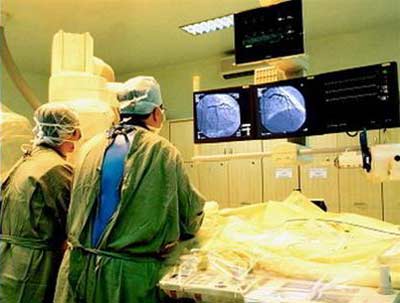This is a type of disease that is increasingly on the rise with the development of society. The disease does not exhibit clear symptoms but is very dangerous due to many unpredictable consequences…
Unpredictable Consequences
According to Dr. Tran Trieu Thanh Truc from the Cardiology Department of Trưng Vương Emergency Hospital, high blood lipids can have primary causes: hereditary factors (having family members with the disease); secondary causes: other diseases such as hypothyroidism, hyperthyroidism, nephrotic syndrome, diabetes, pituitary gland failure, and alcohol consumption…
A person with high blood lipids often shows no distinct symptoms. Most cases are discovered accidentally when patients undergo routine health check-ups or seek medical attention for symptoms of other diseases such as diabetes, hypertension, or upper abdominal pain…

Vascular imaging for cardiovascular diagnosis at the University of Medicine and Pharmacy – Ho Chi Minh City (Photo: B.V)
Dr. Thanh Truc warns that uncontrolled lipid disorders can lead to many dangerous diseases. Specifically, when harmful lipids increase (elevated triglycerides, increased LDL cholesterol), these substances can accumulate on blood vessel walls, causing atherosclerosis, which narrows the blood vessels. If left untreated, this fatty layer thickens and can obstruct the blood vessels, resulting in insufficient blood flow to organs.
Depending on the affected blood vessels, different symptoms can occur: extremely high blood pressure can cause cerebrovascular accidents or paralysis; insufficient blood supply to the heart can lead to angina or myocardial infarction; blood deficiency or blockage in the legs can cause intermittent claudication (cold, painful legs when walking a short distance, requiring rest to alleviate pain), and black necrosis of the feet or toes depending on the location of the blockage; acute pancreatitis.
Diet and Exercise
|
Dr. Nguyen Thi Hoa, head of the Nutrition Department at Children’s Hospital 1, states that children with obesity also experience high blood lipids. A study by Dr. Hoa on 330 obese children aged 24 months to 15 years showed that 86.7% had elevated blood lipid levels. Among them, 74.3% had high triglycerides, 12.3% had elevated cholesterol, 13.9% had LDL levels above normal, and 11.7% had low HDL levels. Additionally, 60.9% of patients had fatty liver disease. |
Dr. Ly Huy Khanh, deputy head of the Planning Department at Trưng Vương Emergency Hospital, notes that in developed countries, the leading cause of death is heart disease (32%), primarily due to atherosclerosis. In our country, atherosclerosis, manifesting as coronary artery disease, sudden death, myocardial infarction, and strokes, is increasingly common with societal development.
Men over 40 and women who are menopausal or over 50, along with individuals with high-risk factors such as smoking, hypertension, diabetes, abdominal obesity, or a family history of heart disease, should undergo regular check-ups to detect elevated blood lipids. If no high-risk factors are present, monitoring should occur at least once every five years; if high-risk factors are present, annual monitoring is necessary.
Regarding treatment, Dr. Thanh Truc explains that elevated blood lipids can be treated and controlled before it is too late. This adjustment should primarily begin with dietary changes. Medication should not be rushed. If obesity is present, weight loss is essential; reduce animal fat intake and instead consume vegetable oils, eat more fish, fruits, and vegetables, and drink soy milk.
If cholesterol levels are high, it is advisable to limit consumption of foods rich in cholesterol, such as kidneys, brains, liver, eggs, butter, and freshwater shrimp; reduce alcohol intake, especially when triglyceride levels are elevated. Additionally, physical activity should be increased: moderate exercise, walking, swimming. Physical activity helps to raise HDL levels. Exercise should be done for at least 30 minutes a day, regularly every day or three times a week.
If only mild to moderate lipid disorders are present, following a diet combined with weight loss is sufficient, and medication should only be used if results are not achieved while continuing to maintain the diet and exercise regimen. Blood lipid levels should be rechecked every three months.
LE THANH HA


















































